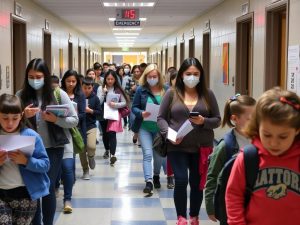Parent-Teacher Conferences can fill even the most seasoned teacher with anxiety. You want to get the parents on your side but without alienating the student, who you will continue to see every day. Instead of you, the teacher, being the bearer of news both good and bad, student-led conferences are an innovative way to help students take responsibility for their own learning, make parents happy, and make conference time much less stressful for you, too.
how do student-led conferences work?
As the name suggests, students are the ones responsible for informing their parents about their academic progress and setting goals for continued improvement and success. While most schools have online grade books that parents and students can check themselves, there are still many who do not. Instead of you, the teacher, leading the conversation about grades or their behavior, it’s the student who is in charge of delivering the pertinent information. By doing this, the students take ownership and are held accountable for their success and struggles in class. To develop metacognition and executive function skills, students also should reflect on their learning process, identify areas to improve, and devise an action plan to achieve certain desired goals.
The Portfolio Method (better for younger grades)
Some schools will have students compile a portfolio of sorts with exemplars of their past work or current projects — the materials could be collected in a file folder, crate, binder, a Google Slides presentation, a video, etc. Teachers may want to create a system for student portfolios where students periodically select and organize assignments in a central place, or where they must include specific items that are representative of the curriculum. They can then walk their parents through the learning process for each piece, describing the objective of the lesson, the process, the results, and what they learned. Students can inform their parents of their grades, or this is where the teacher can step in and deliver the report. Here are more ideas of items that students can show their parents to demonstrate their learning:
- their desk/work area/cubby/notebook
- assignments or projects they are particularly proud of
- assignments or projects they struggled with
- the rough draft and final draft of a written assignment
- artwork, video, craft, or poster they created
- an online learning game they mastered
- teach the parents how to solve a math problem
- read aloud from their current book, their journal, an essay
- disciplinary referrals, demerits, detention slips
- assessment scores
- goals for growth
The Presentation Method (better for middle or high school)
Another way students can deliver the necessary information is through a speaking presentation, video, podcast, or other media. Some schools prepare a master copy of a Google Slides and each student makes their own copy to use. Students will simply click through the presentation while explaining ideas to their parents. These slides should include much more information than just a current grade — a great practice is to have students reflect on their work and type an explanation as to why they have the grade they do. This isn’t just about having the student take ownership of a poor grade; it’s equally as important for them to reflect upon what they have done successfully to achieve good grades, too. Here are some items or prompts you may want to require students to answer:
- My current grade is…
- I have this grade because…
- My favorite assignment/activity/project/lab was…
- The most interesting thing I’ve learned in this class is…
- In this class, I struggle with…
- Something I need help with is…
- To improve/maintain my grade, I need to…
- My behavior in this class is…
- One goal I have for this class is to…and the steps I will take to achieve that goal are…
So, what’s the teacher’s role in student-led conferences?
You, your students, and their parents may be wondering, “Well, what is the teacher supposed to do? Couldn’t the students just do this at home?” By having a scheduled conference time, you as the teacher can ensure it actually gets done. Parents must make the concerted effort to be there, students can’t conveniently “forget”, and you are there to corroborate, confirm, or deny what the student is saying. Students will sometimes gloss over a poor grade or say that their behavior is “fine,” so you are there for quality assurance — to fill in any gaps, ask probing questions, or explain things further for the parents. Teachers can also help the students in setting goals — such as academic achievement, behavior control, or skill development — and provide strategies for parents to help their child meet those goals.
What’s the parents’ role in student-led conferences?
Because the student is leading the conversation, parents are often more engaged in the conference; they will ask their child questions, point out observations, and provide feedback (and sometimes criticism). Of course, parents will probably ask you questions, too — they will want to know the real scoop on their child’s classroom behavior, achievements, work ethic, social interactions, etc.
While there may be some extra work upfront for student-led conferences — getting the students’ current grades, making sure they compile a portfolio or complete the presentation, scheduling, etc. — it also takes some pressure off the teachers who, as you probably know, often receive a lot of blame from parents and students who don’t know any better. Having students take responsibility for their learning and holding them accountable for their successes and failures within the presence of people who care about their education is a great alternative to your standard parent-teacher conferences.
Read more about starting student-led conferences at your school or enroll in self-paced online Professional Development courses for K-12 teachers at Credits for Teachers. Teachers who take our courses receive graduate credit from our university partner that can be used for salary advancement or license renewal – Learn More Now



